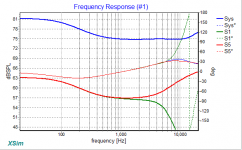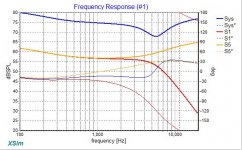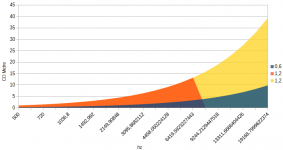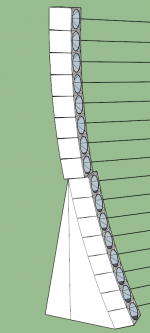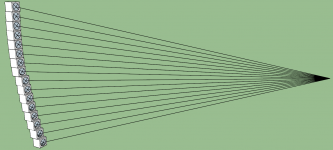First of all, don't know if this belongs here or in the fullrange forum. Using fullrange drivers but not playing all of them FR. (Technically a series 1.5 way?)
I have played around with XSim lately, and came up with a line array with a stepped baffle. Half the drivers playing fullrange, and half low passed at something like 5k hz(?).
The drivers stay in phase up to 6k hz, and at that point there's a ~7.5db diff between them.
Didn't use any driver data as this is kind of just hypothetical. Used 8 drivers in the circuit just to get the right impedance.
Pros and cons of doing something like this? Time smear? Comb filtering? Smaller difference in critical distance between low and high frequencies.
(2^2 * 3000hz)/700 = 17.14m
(1^2 * 12000hz)/700 = 17.14m
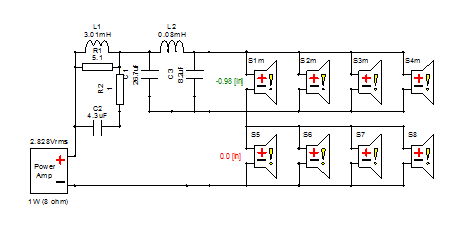
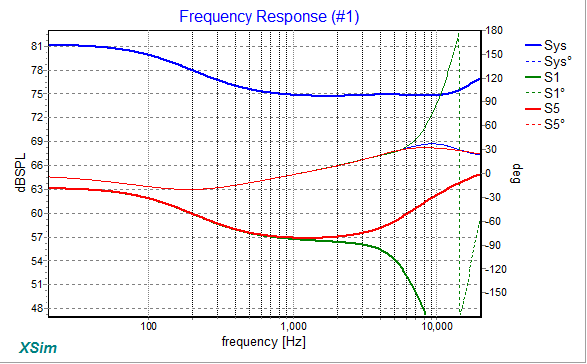
I have played around with XSim lately, and came up with a line array with a stepped baffle. Half the drivers playing fullrange, and half low passed at something like 5k hz(?).
The drivers stay in phase up to 6k hz, and at that point there's a ~7.5db diff between them.
Didn't use any driver data as this is kind of just hypothetical. Used 8 drivers in the circuit just to get the right impedance.
Pros and cons of doing something like this? Time smear? Comb filtering? Smaller difference in critical distance between low and high frequencies.
(2^2 * 3000hz)/700 = 17.14m
(1^2 * 12000hz)/700 = 17.14m
Attachments
Last edited:
I'm interested to hear what some of the more technically inclined will say about this approach. I am considering something very similar with the 60 Vifas I have. My approach would be much like an MTM/WMW configuration using 8-12 drivers in the center in OB similar to the Nola Grand Reference with the upper and lower drivers sealed to extend the bottom end. Looking forward to what "they" have to say.
Hi, M8e, i do not understand the circuit, cannot see, where lines knot and where they only cross. Anyway, it seems, that thy plan becomes right, if thou exchange the step for a ramp, say use filters of first order. This is used, see CBT and Krassolito! As we are in a digital forum, i should also mention Horbach-Keele, which also has a symmetrical driver arrangement but uses finite-impulse-response filtering.
Last edited:
There is no crossing lines in the circuit.
C1, L2 and C3 is a series 3rd-ish order low pass adjusted to phase match as far as possible(or at least match by a few degrees.) But then do "whatever". As it's series circuit there is no 0.5 way "gain".
L1 and R1 is a BSC circuit.
C2 and R2 is to adjust the high frequency response. Really just to compensate for the weird response caused by the series low pass doing "whatever".
Not really sure what you mean with a ramp. But I had I had in mind an focused/concave array, where the low passed drivers is offset forward. The simulation uses 0.98 inch, but that's just what I ended up with.
C1, L2 and C3 is a series 3rd-ish order low pass adjusted to phase match as far as possible(or at least match by a few degrees.) But then do "whatever". As it's series circuit there is no 0.5 way "gain".
L1 and R1 is a BSC circuit.
C2 and R2 is to adjust the high frequency response. Really just to compensate for the weird response caused by the series low pass doing "whatever".
Not really sure what you mean with a ramp. But I had I had in mind an focused/concave array, where the low passed drivers is offset forward. The simulation uses 0.98 inch, but that's just what I ended up with.
Usually in line arrays the bass is the only stepped part. The issue is vertical lobing.
Imagine a time-coherent/aligned 2-way speaker, with a tweeter over a woofer. As you turn the speaker, your head remains in about the same distance from the drivers as if it was in front, so there's reduced phase effects and lobing.
Turning the speaker on it's side however, and now you are only aligned with the drivers when directly in front of them. Turn the speaker one way and you are much closer to the tweeter, the other, the woofer. This problem is actually made worse by the stepped baffle.
You'll have better vertical dispersion of a line array with a tweeter and mid in the same plane. See the early Genesis towers. I hear they had terrible crossovers, but the images are sound, or the larger Nola's or the Keele line array.
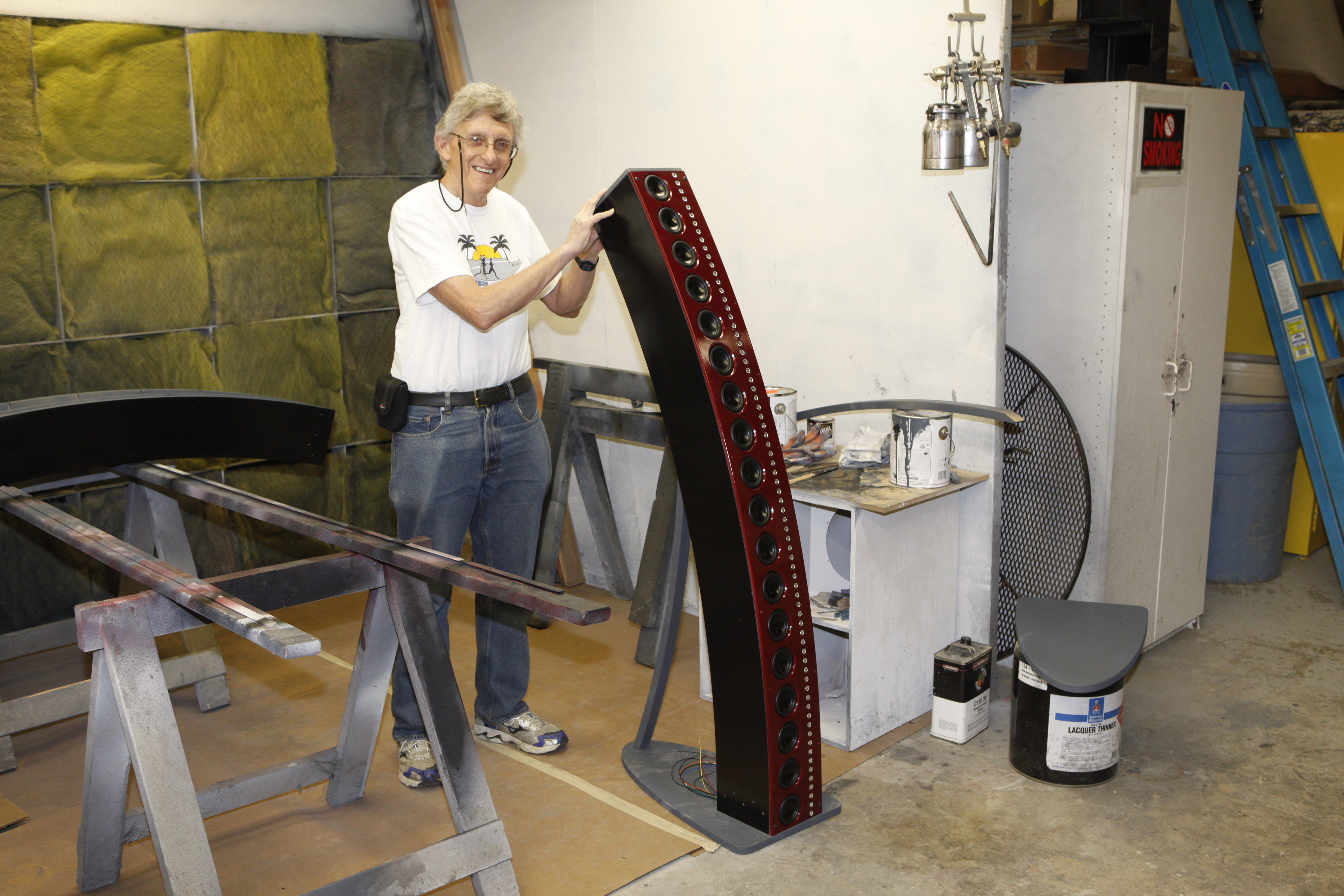
Best,
Erik
Imagine a time-coherent/aligned 2-way speaker, with a tweeter over a woofer. As you turn the speaker, your head remains in about the same distance from the drivers as if it was in front, so there's reduced phase effects and lobing.
Turning the speaker on it's side however, and now you are only aligned with the drivers when directly in front of them. Turn the speaker one way and you are much closer to the tweeter, the other, the woofer. This problem is actually made worse by the stepped baffle.
You'll have better vertical dispersion of a line array with a tweeter and mid in the same plane. See the early Genesis towers. I hear they had terrible crossovers, but the images are sound, or the larger Nola's or the Keele line array.

Best,
Erik
Right now it's kind of hypothetical. Not even sure if I or the idea is sane.
But maybe something like Monacor SPH-30x or Monacor SPX-31M, depending on length.
Full height line = cheaper drivers.
Half height = higher quality.
@eriksquires: In case I haven't been clear. All the drivers would be the same and all off them in a vertical line(seen from the front). ie the drivers playing fullrange would be closest to ear level and the low passed drivers above/below those driver.

But maybe something like Monacor SPH-30x or Monacor SPX-31M, depending on length.
Full height line = cheaper drivers.
Half height = higher quality.
@eriksquires: In case I haven't been clear. All the drivers would be the same and all off them in a vertical line(seen from the front). ie the drivers playing fullrange would be closest to ear level and the low passed drivers above/below those driver.
To get a sound as clean as possible do build every speaker in its own little cube, box. And: Everytime you could order the array in height, depth and so on.
What is the distance listener - speakers and speaker - speaker?
Which amp do you use?
What is the distance listener - speakers and speaker - speaker?
Which amp do you use?
Both distances is pretty much 3 metres. Right now I'm using an Onkyo tx-nr636, but I'm looking for something with better EQ.
I kind of like the idea of building individual boxes. Then I could try different configurations (Different focal points, pointing drivers to the focal point vs horizontally, different step depths, half/full height, ear level...).
The same boxes would be used for the surround satellites
I kind of like the idea of building individual boxes. Then I could try different configurations (Different focal points, pointing drivers to the focal point vs horizontally, different step depths, half/full height, ear level...).
The same boxes would be used for the surround satellites
Last edited:
Tzzz. Tzzzzzzzzzz,-)
A surround-story,-? Very very difficult to implement, in my mind.
X same amps, if possible se, ONE psu for all, including preamp. Same drivers, fullrange, bigger ones, because, my mind, without subwoofer...
Very very difficult to get a homogeneous, clean, clear sound. The most confuse EQ and much technology with clean sound, deepths, spaciousness ...
Tzzzzz,-)
My mind: First you have to build a good surround-amp - in my mind.-) You can not buy, nowhere in business, not for 1.000.000 $€£,-) I would build some 5 - 10 watt se, ONE psu. Very easy. Use a little cheap preamp, "decoder". Try to use the ONE psu.
My minds,-D
The Monacors will run very very good, stepped or not.-!
A surround-story,-? Very very difficult to implement, in my mind.
X same amps, if possible se, ONE psu for all, including preamp. Same drivers, fullrange, bigger ones, because, my mind, without subwoofer...
Very very difficult to get a homogeneous, clean, clear sound. The most confuse EQ and much technology with clean sound, deepths, spaciousness ...
Tzzzzz,-)
My mind: First you have to build a good surround-amp - in my mind.-) You can not buy, nowhere in business, not for 1.000.000 $€£,-) I would build some 5 - 10 watt se, ONE psu. Very easy. Use a little cheap preamp, "decoder". Try to use the ONE psu.
My minds,-D
The Monacors will run very very good, stepped or not.-!
Thanks! A ramp has a smaller steepness than a step of a stairway. We hear frequencies and as such wavelengths continously, as broad as over one millennium and as fine as the inverse of a millennium. Wolves howl, sweeping frequency. I do not know any animal, which steps frequency, maybe a deer singing the octave overblowing. I do not understand, what thy calculations and most of their numbers, the two power equations in thy first post and the 0.98 inch, are related to.There is no crossing lines in the circuit.
C1, L2 and C3 is a series 3rd-ish order low pass adjusted to phase match as far as possible(or at least match by a few degrees.) But then do "whatever". As it's series circuit there is no 0.5 way "gain".
L1 and R1 is a BSC circuit.
C2 and R2 is to adjust the high frequency response. Really just to compensate for the weird response caused by the series low pass doing "whatever".
Not really sure what you mean with a ramp. But I had I had in mind an focused/concave array, where the low passed drivers is offset forward. The simulation uses 0.98 inch, but that's just what I ended up with.
I understand the confusion. Like, baffle step and stepped baffle could get lost in translation...
The ~1 inch is a literal step in the speakers front baffle, so the low passed driver(s) is 1 inch closer to the listener and the sound from that driver will be 74 µs (microseconds) earlier.
This compensates somewhat for the phase delay caused by the filter, so that the speakers can stay in phase up to 6000 hz. (and at that point there a something like 7-8db difference between them)
Without this step the phase response would look like this:
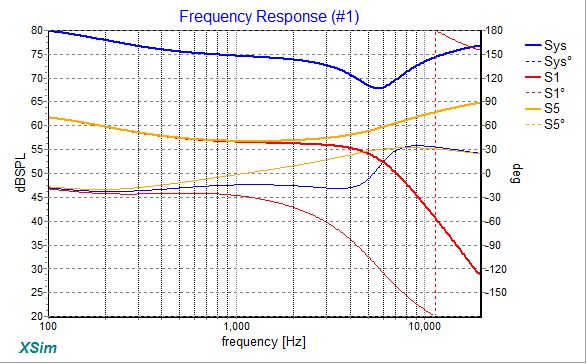
With step:
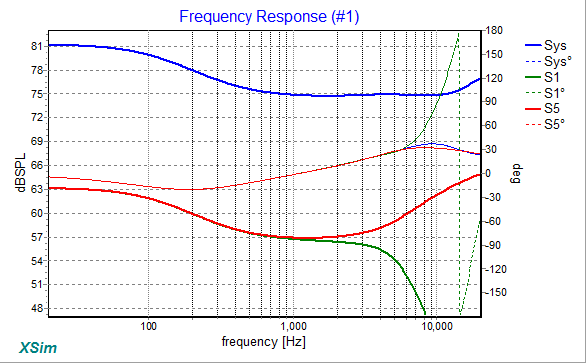
edit: Oops, different colors, and minimum frequency(10hz/100hz).
The ~1 inch is a literal step in the speakers front baffle, so the low passed driver(s) is 1 inch closer to the listener and the sound from that driver will be 74 µs (microseconds) earlier.
This compensates somewhat for the phase delay caused by the filter, so that the speakers can stay in phase up to 6000 hz. (and at that point there a something like 7-8db difference between them)
Without this step the phase response would look like this:
With step:

edit: Oops, different colors, and minimum frequency(10hz/100hz).
Attachments
Last edited:
concave array
M8e,
I think your idea is definitely sane. There are several posters with experience with full range concave arrays that would say that you will end up with a very defined sweet spot...."head in a vice" listening experience. My own experience with concavity is limited to a top end of about 2500 Hz and I was left with uncertain results regarding this issue. But of course you are not going full range for the entire array.
I am not sure I understand what you mean by critical distance. Please define it.
M8e,
I think your idea is definitely sane. There are several posters with experience with full range concave arrays that would say that you will end up with a very defined sweet spot...."head in a vice" listening experience. My own experience with concavity is limited to a top end of about 2500 Hz and I was left with uncertain results regarding this issue. But of course you are not going full range for the entire array.
I am not sure I understand what you mean by critical distance. Please define it.
I'm not sure if it's actually the right name for it.
It's the (theoretical) distance from the line where it stops working like a line source(horizontal dispersion, 3dB drop off doubling the distance) and instead starts to spread like a point source.(horizontal+vertical dispersion and 6 db drop off doubling the distance.)
But that's asuming a perfect line source and no walls/reflective surfaces, et.c...
What if one pointed the drivers horizontally instead of towards the focal point. Would that be less "vice"? Or make the array curved with an ~3 meter radius put pointing the drivers at an focal point at something like 6 meters?
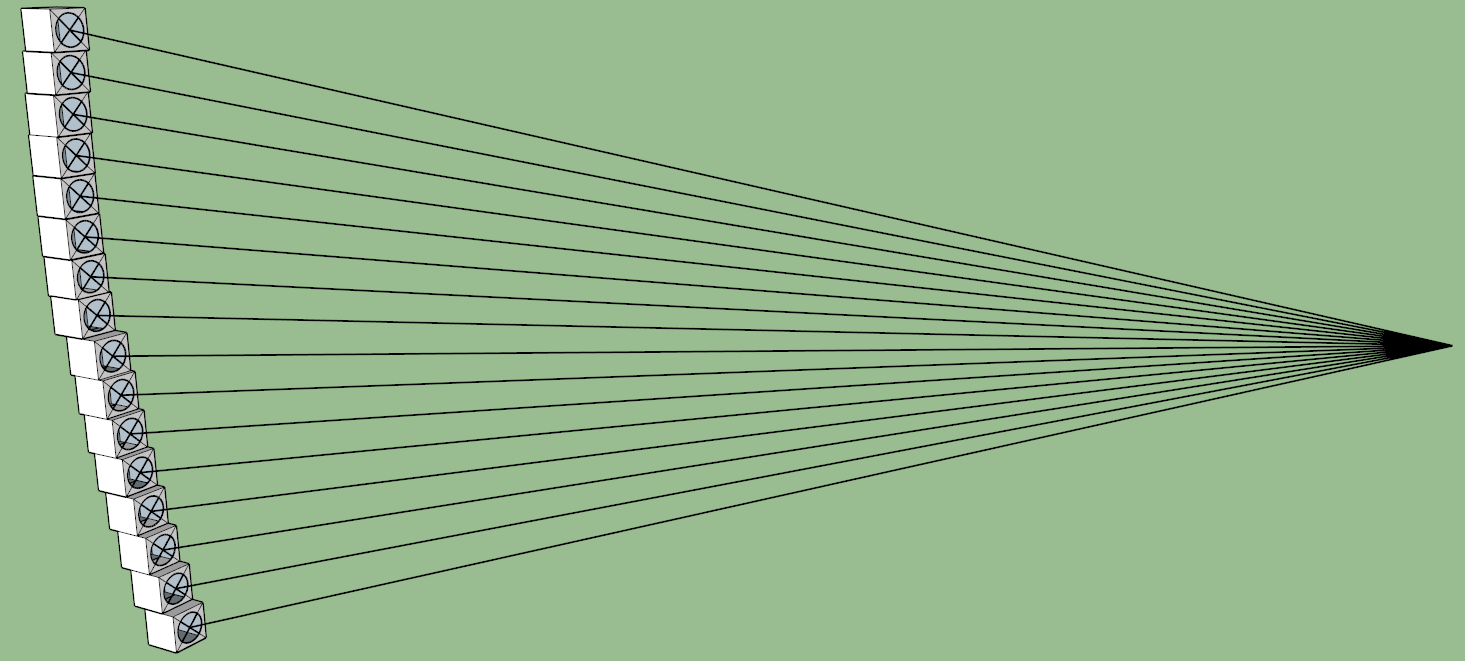
It's the (theoretical) distance from the line where it stops working like a line source(horizontal dispersion, 3dB drop off doubling the distance) and instead starts to spread like a point source.(horizontal+vertical dispersion and 6 db drop off doubling the distance.)
But that's asuming a perfect line source and no walls/reflective surfaces, et.c...
What if one pointed the drivers horizontally instead of towards the focal point. Would that be less "vice"? Or make the array curved with an ~3 meter radius put pointing the drivers at an focal point at something like 6 meters?
Attachments
Last edited:
OK "critical distance" is the near/far field transition point.
I didn't' worry about pointing the drivers as off axis response was not a concern at 2500 Hz. Since you are not going full range for all drivers you may not need to worry about that.
I would not make the focal point the same as the listening position. I tried 0.5x the focal point as you have suggested.
I didn't' worry about pointing the drivers as off axis response was not a concern at 2500 Hz. Since you are not going full range for all drivers you may not need to worry about that.
I would not make the focal point the same as the listening position. I tried 0.5x the focal point as you have suggested.
Did you read Wesayso's two towers thread?
He talks in length about all this, and more.
Basically, line arrays NEED a lot of help to shine. Building one and applying a little EQ won't do. Even with power phasing/delaying. Just look at how much EQ is needed for the IDS-25.
Save you the trouble and have a look at DRC. It will be your best tool to tackle the intricacies of line arrays.
He talks in length about all this, and more.
Basically, line arrays NEED a lot of help to shine. Building one and applying a little EQ won't do. Even with power phasing/delaying. Just look at how much EQ is needed for the IDS-25.
Save you the trouble and have a look at DRC. It will be your best tool to tackle the intricacies of line arrays.
Yes, I have read it. But I'm not sure how much of it applies to focused arrays(or at least timed arrays,) instead of straight arrays, and how much applies to fullrange speakers in general, or possibly all speakers.
There's also phantom center, stereo imaging, 3D stuff that's to me just seem like, well "shine". No need for a phantom centre with a real centre.
I would argue that all speakers needs "help", DRC, IIR and all the acronyms(and non-acronyms) to really shine. Do we need shiny speakers?
There's also phantom center, stereo imaging, 3D stuff that's to me just seem like, well "shine". No need for a phantom centre with a real centre.
I would argue that all speakers needs "help", DRC, IIR and all the acronyms(and non-acronyms) to really shine. Do we need shiny speakers?
Last edited:
Focused array is an excellent option, so long as you are beyond the focus point.
Small drivers, no whizzers, less distortion, more volume, no phase problems.
Above, below, and beyond focus was still very good, just not the best.
I was surprised that the image was only as tall as the 3 middle drivers.
Best thing i've ever had.
I just wasn't using it right and was into way louder volumes and music a few years ago.
I had a 9 x 4" array concave.
Wide dispersion of a 4" yet cone area of a 12".
Expensive and difficult to make, but worth it if you are into full range drivers.
I will say, don't have have a bunch of cubes, you will have a huge peak near 1khz assuming a 6" cube.
The f3 is usually high if sealed, so you may have to cross at 200hz.
Don't forget the baffle step.
I'll try to get a pic up late tonight.
Here is a link to the thread.
http://www.diyaudio.com/forums/full-range/221676-mr-bates-your-focused-arrays.html
Norman
Small drivers, no whizzers, less distortion, more volume, no phase problems.
Above, below, and beyond focus was still very good, just not the best.
I was surprised that the image was only as tall as the 3 middle drivers.
Best thing i've ever had.
I just wasn't using it right and was into way louder volumes and music a few years ago.
I had a 9 x 4" array concave.
Wide dispersion of a 4" yet cone area of a 12".
Expensive and difficult to make, but worth it if you are into full range drivers.
I will say, don't have have a bunch of cubes, you will have a huge peak near 1khz assuming a 6" cube.
The f3 is usually high if sealed, so you may have to cross at 200hz.
Don't forget the baffle step.
I'll try to get a pic up late tonight.
Here is a link to the thread.
http://www.diyaudio.com/forums/full-range/221676-mr-bates-your-focused-arrays.html
Norman
Last edited:
- Status
- Not open for further replies.
- Home
- Loudspeakers
- Full Range
- Stepped line array?
